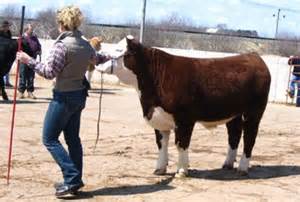Preparing for a Livestock Show
 For 4-H members and spectators alike, livestock shows are one of the most anticipated parts of a fair. Preparing your animal for a show begins months in advance. Great care is needed in feeding your animal, practicing showmanship, and making sure your animal is healthy. After all the time and effort that goes into raising your animal, you want to make sure that you have everything you need once you arrive at the fairgrounds.
For 4-H members and spectators alike, livestock shows are one of the most anticipated parts of a fair. Preparing your animal for a show begins months in advance. Great care is needed in feeding your animal, practicing showmanship, and making sure your animal is healthy. After all the time and effort that goes into raising your animal, you want to make sure that you have everything you need once you arrive at the fairgrounds.
Angel Granger, the 4-H Agent in Jackson County (also a former livestock club leader and 4-Her) suggests investing in a show box or rubber tote to keep all of your show supplies together.
Packing List for Large Animal Shows:
- Grooming tools- scotch comb, brush, shampoo, blower, clippers, scissors
- Feed supplies- feed, hay, buckets, feed tubs (rubber tubs work well)
- General supplies- water hose, spray nozzle, rubber boots, extension cord, extra rope, pitch fork, square point shovel, rake, and wheel barrow. Depending on the time of year, a fan is also a good idea (the temperature tends to change quickly in the fall and spring and can be unpredictable). Also pack a sign or poster about your animal (breed, age, name, sponsor, etc).
- General animal first-aid kit. Antibiotic cream/salve, aspirin boluses and balling gun, blood stop powder, and bleach. It is a good idea to disinfect the sand before you place your animal on the ring. A simple bleach mixture of 1 part bleach to 4 parts water, in a spray bottle will do.
- Show equipment. Show stick, show halter/lead, tie out halter and lead ropes.
Packing List for Small Animal Shows:
- Grooming tools (brush, comb, nail file, nail clippers, grooming apron or old clothes)
- Feed supplies- feed, feed containers, water bottle
- General supplies- bucket, rags, string or tie wire, sign for your animal (name, breed, age, sponsor, etc)
- General animal first aid kit.
- Show equipment- most dog shows require a leash.
Supplies needed for every show regardless of the species you are showing:
- Show clothes. There is no uniform for 4-H, but you will want to dress neatly and modestly. A button down shirt and dark pants are appropriate. A neck tie or 4-H bolero tie is a nice touch. Make sure your hair is neatly styled and pulled back away from your face. You may also want to bring some safety pins for your exhibitor tag.
- Human first aid kit- you can purchase one for less than $10.00, or put one together yourself (band aids, antibiotic ointment, pain reliever).
- Paperwork: A copy of the registration form you mailed/submitted, your animal’s health papers, your lease document (if applicable), and your ORIGINAL breed registry papers. Photocopies will not be accepted at check-in. It is a great idea to put these papers in a three-ring binder inside sheet protectors.
- Your knowledge and good sportsmanship! Be familiar with your animal so that you are prepared to answer any questions the judge may ask. Look over your feed record and record book. Remember to both win and lose gracefully.
Be sure to label your items with your name. Consider laminating your packing list and keeping it in your show box with a dry-erase marker. That way, you can check the items off as you load them into your box or trailer. Being prepared will help you be less nervous and make your experience much more enjoyable. See you at the fair!

